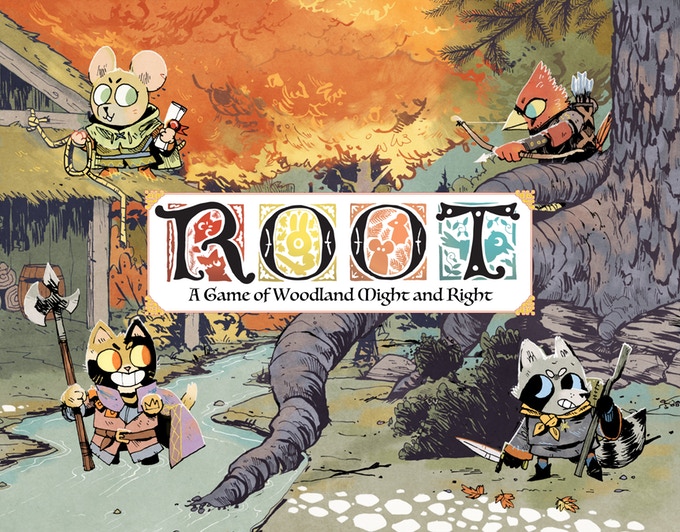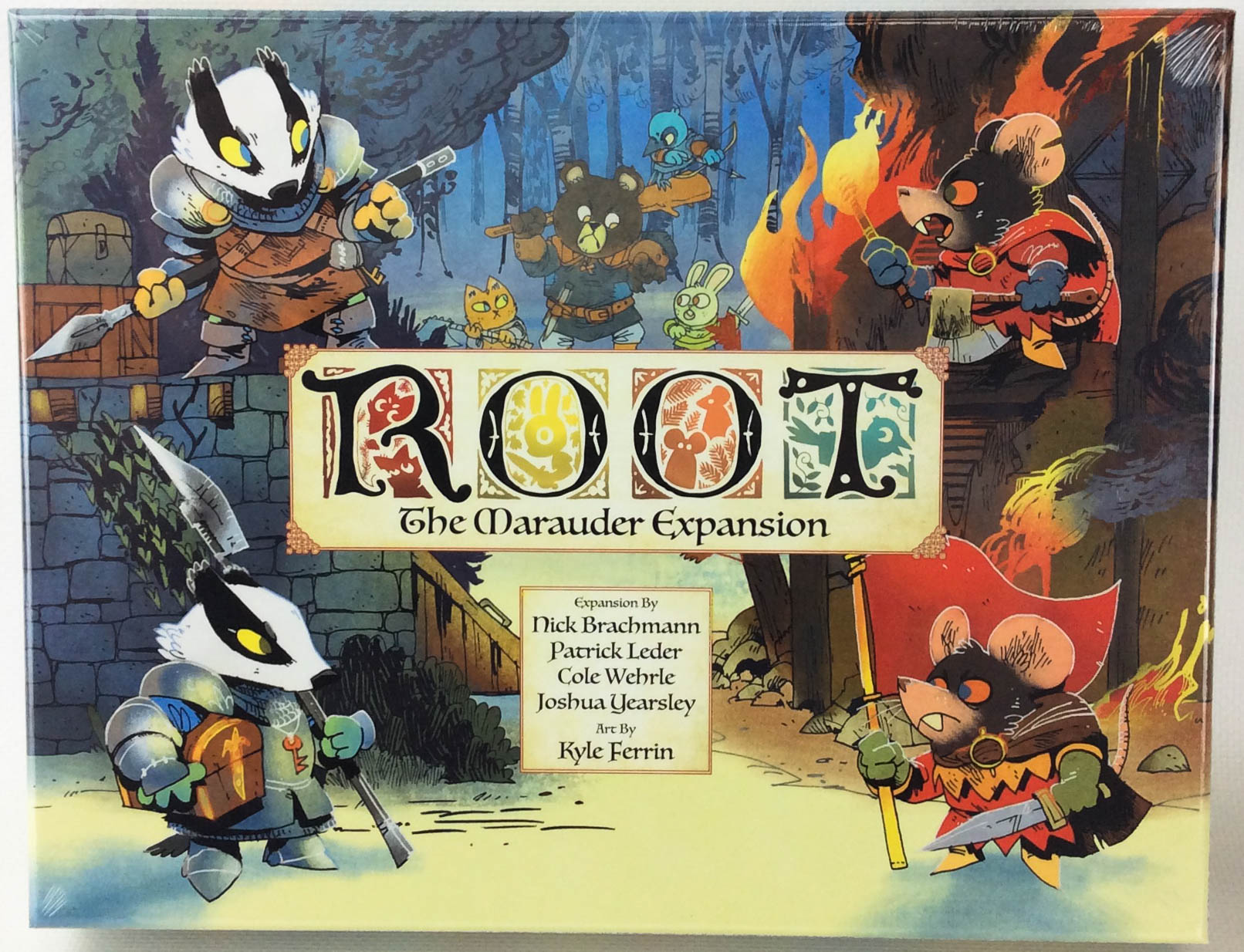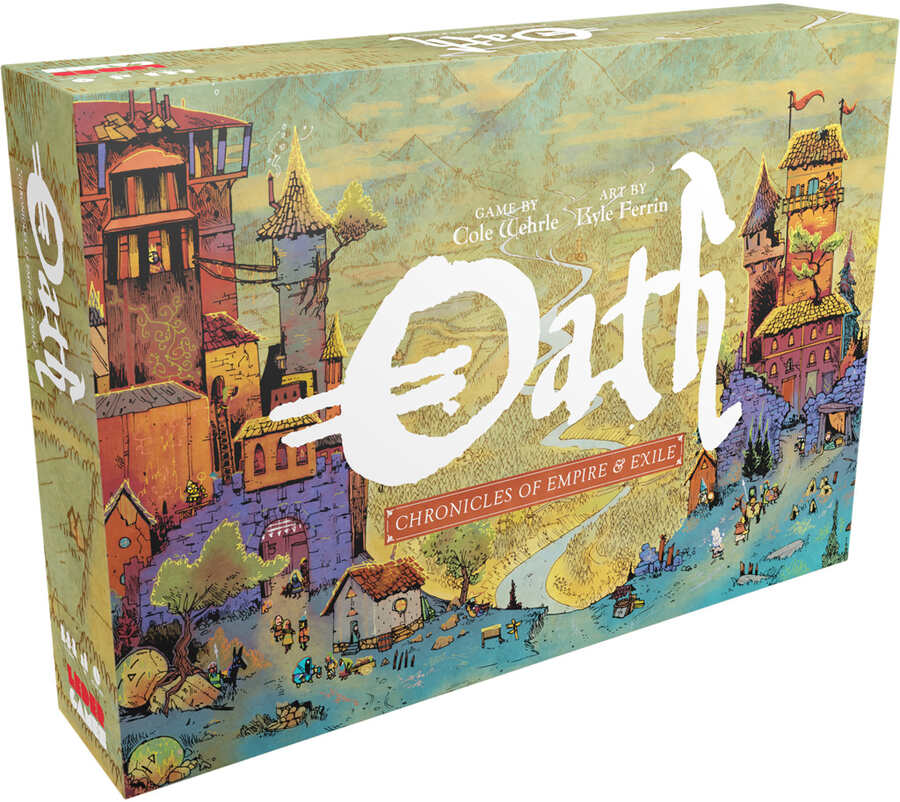Board game designers are like authors and directors (not so much movie stars – I don’t believe People has ever featured Uwe Rosenberg on its cover), spinning their ideas into mechanical constructs that, through play, illuminate the designer’s ideas (and hopefully give everyone a fun time in the process). One of the most effective modern designers at translating concepts to cardboard is Cole Wehrle, whose games may not reach the mass appeal of Catan (though Root’s not far off), but are undoubtedly crafted with a vision in mind.
Today, as Wehrle’s latest design, Molly House, begins to land around the world, we’re exploring his catalog, each of which deserves a look for any board gamer wanting something special in their collection. So read on and consider whether you’re ready to dive into a unique adventure.
Root’s Asymmetric Animal Warfare
I’m starting with Root for the simple reason that it’s likely the Wehrle game easiest to find. The concept for Root, woodland creatures competing to achieve their goals in a beautifully illustrated forest, is as belying a sentence as you could type. The game’s box, with its adorable critters and bright colors, brings to  mind a children’s game, where dice will be used to send little animal figures around a track. Should you dare acquire Root without any research, you would soon find this expectation shattered.
mind a children’s game, where dice will be used to send little animal figures around a track. Should you dare acquire Root without any research, you would soon find this expectation shattered.
And replaced, in due time, with something much more compelling.
See, Root does indeed cast you and your friends as disparate members of warring woodland factions. Derived from GMT’s COIN wargames, Root isn’t content to differentiate its factions by color alone. Instead, the cats and the birds, the raccoon Vagabond and, should expansions be acquired, oddities like cultish lizards or a horde of rats all operate according to their unique rules. Everyone is racing towards a points threshold, but how they get there will be different from everyone else.
Upfront, this setup puts Root in a daunting position – playing the game effectively means learning your own faction’s idiosyncrasies while also knowing enough about your opposing critters to stop their plans. Often, this interdiction is irregular: you might trade with the Vagabond to help both of you on one turn, and set about bashing that raccoon on the next to keep it from winning. Or your cats might swoop in to claim a clearing before the birds can get there, blocking the Eyrie’s required move and, thus, forcing the bird government to fall apart.
Yes, bird governments are a thing in Root.
For all that, I’d say getting going in Root isn’t all that hard. Focus on your animals, get surprised by what the others are able to do, and then rinse and repeat. You’ll have fun regardless, and the core rules aren’t so dense (especially coupled with the solid, included tutorial) as to make any gaming group ready for medium-weight jazz bounce off. Solving the faction puzzles feels like a triumph, and once Root has its claws in you, you’ll find expansions aplenty to explore:
Riverfolk: Lizards and Otters jump into the game. The former operate a cult, while the furry mammals thrive in the river waterways. Unique and best explored in games stuffed with other players, as both lizards and otters operate a little outside of just bashing everyone to pieces, Riverfolk makes a strong first acquisition if you’re often playing Root with a full table.
Marauder: Rats and badger knights! Perhaps mandated in Wisconsin with those badgers, Marauder nevertheless holds its own at lower player counts and offers two strong, martial factions predicated on direct conflict.
offers two strong, martial factions predicated on direct conflict.
Underworld: Moles lead a righteous crusade to the surface, while crows use their guile to take hostages and conduct nefarious schemes. A blend of faction types, coupled with two new maps, make this a great choice when you’re looking for a big Root refresh.
Clockwork: If you’re playing solo, the clockwork expansions give Root character, mixing up the game with surprising AI opponents. As an aside, you might also consider this if you’re the primary Root teacher, as playing with Clockwork can help the game fall into place so you can do the same for your friends.
And, lastly, the Exiles and Partisans deck, The Landmarks Pack, Hirelings Packs, and Vagabond Pack are small add-ons that bring changes well beyond their size. They’re the stocking stuffers of Root additions, but you’ll find them well worth acquiring.
Pax Pamir Weaves A Twisting Tale
Dip away from a cute critter forest to the historical Great Game of Afghanistan and you’ll find another Wehrle work of complicated genius. Pax Pamir, and, in particular, Pax Pamir 2nd Edition, achieve some of board gaming’s interactive heights. You and three others—this one’s best played at four, with everyone tugging at the game’s snarled threads—play as either deities, warlords, or the immutable hand of commerce in directing several factions in hopes of leading your chosen one to victory.
The twist, like an 18xx game gone mad, is that your faction can change at a whim.
Picture a growing Britain, their military sprawling across the map and laying claim to territories left and right. You’ve been instrumental in this growth, earning points at every scoring opportunity as you climb towards victory. Then, disaster. A spy and a few choice cards played from the shifting market, which acts like a waterfall of fate, and Britain’s on its back foot, the local Afghans ascendant. In most other games, you’d be thrown into a desperate struggle to claw back relevance or, perhaps, be consigned to a slow fading into last place, eyeing your phone and pondering what snacks to eat as your ability to affect the game dwindles. Not so here. Snag the right card—and there are many opportunities, this isn’t an Ark Nova-style deck where the one card you need is mingled with a thousand others—and you can hang a new flag outside your embassy, suddenly a loyal member of the Afghan faction.
This changeover comes at some cost, as you’ll need to toss loyal servants and replace them with ones whose enthusiasm matches your newfound tastes. Yet, keeping your options open to take advantage of Pax Pamir’s shifting sands marks the brilliance in the game. It’s not all that complex, the depth and dance coming from your fellow players. All this, too, in less than a couple of hours, with setup done in moments. If you want your board game night to be about your fellow players, then Pax Pamir belongs on your table.
Arcs Combines Cards and 4X Sci-Fi
One of the hottest games of 2024, Arcs sees Wehrle bringing his unique style to sci-fi through a deep (stick with me) trick-taking mechanic. Quite a bit more than Hearts: In Space, Arcs sees you and up to three others, and this one plays best at 3-4, because it’s all about the interaction. Like every game on this list,  Arcs is all about throwing players into the mix with one another. Not just in card play, but in combat, diplomacy, and taxing each other for resources. All this is driven through that card play.
Arcs is all about throwing players into the mix with one another. Not just in card play, but in combat, diplomacy, and taxing each other for resources. All this is driven through that card play.
Every game, players will set scoring ‘Ambitions’ that provide direction for the table and fodder for squabbling. You might need to take and hold territory, acquire the most fuel, or win the most battles (for some examples). Whether or not you draw into the best hand to do any of these things is, at first, seemingly a function of luck. What makes Arcs work, however, is managing those less-than-ideal hands to set yourself up for a strong future turn (or another Ambition in a later chapter of the game). While I’m not sure Wehrle would appreciate my constant comparisons to Hearts, understanding you might not shoot the moon, or accepting a couple of points to avoid taking 10, gets to some of the strategy here.
Arcs depends on you bringing that acumen, or being willing to develop it, as the game will run around two hours, or longer (over several sessions) if you dive into The Blighted Reach expansion, which includes a nifty campaign mode. Your faction evolution and the story that unfolds over the campaign is a treat for anyone that enjoys Arcs at its core, and something I’d definitely look into if you have a group that digs this sci-fi mixer.
Oath is Emergent Narrative, The Game
All of Cole Wehrle’s titles put a fresh spin on their chosen genre, and Oath is no different, choosing to take the heavy mantle of campaign games and change it to a fluid cloak, one re-spun every game by the players themselves. You’ll find no elaborate storybook here, save the one you and your friends write in at every game’s conclusion. There are royals and rebels, allies and enemies. Ever-changing areas to scuffle over, and choices to make that ripple directly down the play sessions.
Oath springs its ideas upon you from the get go, with secrets and coins and troops scattered across a beautiful board bearing locations to loot and conquer. Depending on where fate has cast you in the game, you’ll have several routes to victory, though most will be impossible without the conditioned help of other players. Even the Chancellor, with their intimidating military, can’t simply quash everything. Instead, deals must be struck, favors offered, and trust grudgingly given. Players in weaker positions must often unite to bring down the powerful, but the best in that alliance will position themselves to take the crown for their own. And if you cannot achieve those heights, perhaps a knife to another’s back will guarantee a better setup for the next game.
Depending on where fate has cast you in the game, you’ll have several routes to victory, though most will be impossible without the conditioned help of other players. Even the Chancellor, with their intimidating military, can’t simply quash everything. Instead, deals must be struck, favors offered, and trust grudgingly given. Players in weaker positions must often unite to bring down the powerful, but the best in that alliance will position themselves to take the crown for their own. And if you cannot achieve those heights, perhaps a knife to another’s back will guarantee a better setup for the next game.
Thus, Oath’s campaign is a player’s construct, and when embraced, offers a singular magic unlike anything else.
A step up from Root in complexity and utterly dependent on a group committed both to learning Oath’s wily ways and embracing the role play inherent to its design, this is a gem game for some groups that will, yet, be inscrutable to others. A sign for the former will be not only your taste for heavier games, but ones that encourage deep interaction, especially with a side of deal-making. I’ve mentioned 18xx in this article already, but those titles, and ones like Here I Stand or Wehrle’s own John Company, will evince a clear line to enjoyment with Oath.
Should you trace that line with success, however, then you are in for something special.
Diving into the Wehrle-verse means immersing yourself in challenging, rewarding rulesets with gameplay unlike anything else in the hobby. You’ll find engrossing themes (and I didn’t even mention An Infamous Traffic) blended intricately with mechanics at a level of complexity somewhere north of a mid-weight euro but not at a wargame’s intensity. Components, art, and general style will bring curious eyes to your table, and, if they’re open to something new, they’ll stay.
Yet, I would most recommend Wehrle’s catalog to those with a consistent group of 3-5 players, ones who want to dig deep into these masterpieces and discover all the strategy, fun, and stories waiting within. If that’s you, well, what are you waiting for?
Read our previous article here!
